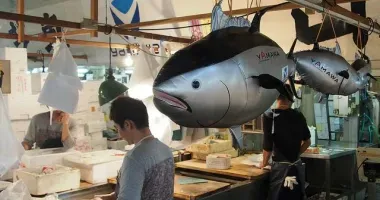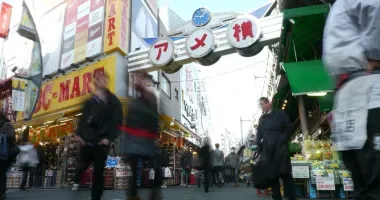Ameyayokocho: Tokyo's vibrant market street
- Published on : 29/06/2024
- by : Japan Experience
- Youtube
Nestled in the heart of Tokyo's Ueno district, Ameyayokocho (アメヤ横丁) is a bustling market street that pulses with energy and charm. This vibrant shopping area, often called Ameyoko for short, stretches for about 400 meters between Ueno Station and Okachimachi Station. With over 400 shops crammed into this compact space, Ameyoko offers an unparalleled shopping experience that attracts both locals and tourists alike. From fresh seafood and exotic spices to trendy fashion and quirky souvenirs, this market has it all. As you navigate through the narrow alleys and crowded walkways, you'll be immersed in a sensory feast of sights, sounds, and smells that embody the essence of Tokyo's street culture. Whether you're a bargain hunter, a foodie, or simply curious about Japanese urban life, Ameyayokocho promises an unforgettable adventure.
History and origins of Ameyayokocho
The history of Ameyayokocho is as colorful and diverse as the market itself. Originally a residential area, it was transformed in the aftermath of World War II. The entire district was razed to the ground during wartime bombing raids, but from these ashes rose a vibrant black market. In 1946, local authorities began to regulate the area, marking the birth of today's street market.
The name "Ameyayokocho" has two potential origins, both rooted in the post-war era. One theory suggests it comes from "ameya" (飴屋), meaning "candy shop", as the market was known for its candy stalls when sugar was scarce. Another theory posits that "ame" stands for "America", referring to the American army surplus goods sold there. This connection to the Edo period and post-war Japan adds a layer of historical significance to your shopping experience.
As Japan's economy recovered and grew, Ameyoko evolved from a black market into a legitimate shopping district. It became not just a place for locals to find necessities, but also a tourist attraction, drawing visitors from across Japan and around the world. Today, while you can still find echoes of its past in the bargain prices and lively atmosphere, Ameyoko has become a modern market that reflects the diversity and dynamism of contemporary Tokyo.
Navigating Ameyayokocho: Location and access
Ameyayokocho is conveniently located in the heart of Tokyo, making it easily accessible by public transportation. The market stretches along the Yamanote Line tracks between JR Ueno Station and Okachimachi Station. To reach Ameyoko, you have several options:
- JR Ueno Station: Exit from the Shinobazu Exit and you'll find yourself at the northern entrance of Ameyoko.
- JR Okachimachi Station: This puts you at the southern end of the market.
- Tokyo Metro Ueno-Hirokoji Station (Ginza Line): A short walk from here will bring you to Ameyoko.
- Tokyo Metro Ueno-Okachimachi Station (Oedo Line): This station is right next to the market.
Once you arrive, navigating Ameyoko can be an adventure in itself. The main shopping street runs parallel to the train tracks, but don't hesitate to explore the side alleys and adjacent streets. You'll find that Ameyoko Center Building and Ameyoko Plaza house many shops under one roof, offering a respite from the outdoor hustle and bustle.
Keep in mind that Ameyoko can get incredibly crowded, especially on weekends and during sale periods. The narrow walkways can be challenging to navigate, so it's best to visit early in the day if you prefer a more relaxed shopping experience. Remember to stay aware of your surroundings and keep your belongings close in the bustling crowd.
Shopping experience: Bargains, variety, and unique finds
Ameyayokocho is a shopper's paradise, offering an incredible variety of goods at bargain prices. The market is known for its wide selection of products, ranging from fresh produce and seafood to trendy fashion items and traditional Japanese goods. Here's what you can expect:
Clothing and accessories: Ameyoko is famous for its affordable fashion. You'll find everything from casual wear to sportswear, including popular brands like Onitsuka Tiger at discounted prices. Look out for unique items like embroidered bomber jackets that make great souvenirs.
Food and groceries: The market is a food lover's dream. Fresh seafood, fruits, vegetables, and dried goods are available at prices often lower than regular supermarkets. Don't miss the ethnic food market in the basement of Ameyoko Center Building, where you can find ingredients from all over Asia.
Cosmetics and health products: Many shops offer a wide range of Japanese and international cosmetics, often at discounted prices. Drugstores like Matsumoto Kiyoshi are great for stocking up on beauty products and medicines.
Specialty items: Ameyoko is full of unique finds. From traditional Japanese tea at Cha-no-Kiminoen to American lifestyle goods at Garakuta Boeki, you're sure to discover something special.
One of the most exciting aspects of shopping in Ameyoko is the opportunity to bargain. While not all shops allow it, many vendors are open to negotiation, especially for larger purchases. Don't be shy to ask for a better price, but remember to be respectful and reasonable in your bargaining.
Culinary delights: Street food and local specialties
Ameyayokocho is not just a shopping destination; it's also a food lover's paradise. The market is teeming with street food stalls, casual eateries, and restaurants offering a wide array of culinary delights. Here's a taste of what you can expect:
Seafood: Given its origins as a black market for fresh produce, Ameyoko still excels in seafood offerings. Don't miss the chance to try a sashimi bowl at Minatoya Shokuhin. Their "Tokumori Don" is a local favorite, featuring generous portions of tuna, salmon, negitoro, squid, and salmon roe, all sourced fresh from Tsukiji Market.
Street food: As you wander through the market, you'll encounter numerous street food stalls. Try the takoyaki (octopus balls) at Minatoya, or sample some karaage (Japanese fried chicken) at Chicken Man. For a sweet treat, look out for taiyaki (fish-shaped waffle filled with red bean paste or custard) at Taiyaki Kanda Daruma.
International cuisine: Ameyoko's culinary scene reflects Tokyo's international character. You can find Chinese street food at Tentenraku, where their spicy mala hot pot is a must-try. For Korean flavors, head to Uncle Joe for some tteokbokki (spicy rice cakes) or a sweet hotteok (Korean pancake).
Fresh fruit: Hyakkaen New Fruit offers fresh fruit slices on sticks, perfect for a refreshing snack while shopping. Their freshly squeezed juices are also popular, especially on hot summer days.
Traditional sweets: Don't forget to satisfy your sweet tooth! Visit Niki-no-Kashi for an incredible variety of Japanese sweets and snacks. For a more traditional experience, try the matcha ice cream at Chano Kiminoen, a specialty green tea shop.
Remember, eating while walking is generally frowned upon in Japan, so look for designated eating areas or small standing bars to enjoy your street food finds. Many shops also offer samples, allowing you to taste before you buy. Exploring the culinary landscape of Ameyoko is an adventure in itself, offering a delicious glimpse into Tokyo's diverse food culture.
Cultural significance and atmosphere
Ameyayokocho is more than just a market; it's a living piece of Tokyo's history and culture. The vibrant atmosphere here offers visitors a unique glimpse into the heart of the city's street life. As you navigate through the crowded alleys, you're not just shopping - you're experiencing a slice of authentic Tokyo.
The market's origins as a post-war black market have left an indelible mark on its character. Even today, you can feel the entrepreneurial spirit and resilience that helped rebuild Tokyo after World War II. The lively calls of vendors, the art of bargaining, and the eclectic mix of goods all harken back to this era while simultaneously embracing modernity.
Ameyoko is also a melting pot of cultures. While distinctly Japanese, you'll find influences from all over Asia and beyond. The ethnic food market in Ameyoko Center Building, for instance, caters to Tokyo's diverse international community. This multicultural aspect makes Ameyoko a microcosm of globalized Tokyo.
One unique cultural aspect of Ameyoko is the practice of 'tatakiuri'. This is a traditional selling technique where vendors rhythmically clap or bang on boxes while shouting out their wares and prices. It's a form of street performance that adds to the lively atmosphere and is particularly common during busy periods.
Despite its bustling commerce, Ameyoko also has a spiritual side. The Marishiten Tokudaiji Temple, nestled among the shops, offers a peaceful respite from the market's hustle and bustle. This juxtaposition of the sacred and the commercial is quintessentially Tokyo.
Visiting Ameyoko allows you to immerse yourself in the everyday life of Tokyo residents. From salary men grabbing a quick lunch to families doing their weekly shopping, the market provides a window into local life that many tourist attractions can't match. It's this authentic, unfiltered experience that makes Ameyoko a cultural treasure in the heart of Tokyo.
Tips for exploring Ameyayokocho
To make the most of your visit to Ameyayokocho, consider these helpful tips:
1. Timing is key: Ameyoko is generally open from 10:00 AM to 8:00 PM, but individual shop hours may vary. To avoid the crowds, visit early in the morning or on weekdays. However, if you want to experience the market at its liveliest, weekends are the best time to go.
2. Bring cash: While some larger stores accept credit cards, many smaller shops and food stalls are cash-only. There are ATMs available, but it's convenient to have cash on hand.
3. Practice your bargaining skills: Many shops in Ameyoko are open to negotiation, especially for larger purchases. Don't be afraid to ask for a better price, but remember to be polite and reasonable.
4. Try before you buy: Many food shops offer free samples. This is a great way to taste local specialties before committing to a purchase.
5. Explore the side streets: While the main strip is bustling, don't forget to venture into the smaller alleys. You might find hidden gems and less crowded shops.
6. Be mindful of others: The market can get very crowded. Be aware of your surroundings and keep your belongings close. Also, remember that eating while walking is generally frowned upon in Japan.
7. Learn a few Japanese phrases: While many shopkeepers speak some English, knowing basic Japanese phrases like "Ikura desu ka?" (How much is it?) can be helpful.
8. Look for seasonal specialties: Ameyoko offers different products depending on the season. During New Year's, the market becomes incredibly busy as people shop for traditional foods.
9. Take breaks: The market can be overwhelming. Don't hesitate to step into one of the many cafes or visit the nearby Marishiten Tokudaiji Temple for a moment of calm.
Remember, exploring Ameyayokocho is as much about the experience as it is about shopping. Take your time, soak in the atmosphere, and enjoy this unique slice of Tokyo life.
Nearby attractions and points of interest
Ameyayokocho's central location in Ueno makes it an excellent starting point for exploring other attractions in the area. Here are some nearby points of interest to consider adding to your itinerary:
1. Ueno Park: Just a short walk from Ameyoko, Ueno Park is one of Tokyo's largest and most popular public spaces. It's home to several major museums, including the Tokyo National Museum and the National Museum of Western Art. During cherry blossom season, the park becomes a popular spot for hanami (flower viewing).
2. Ueno Zoo: Located within Ueno Park, this is Japan's oldest zoo and home to over 3,000 animals, including giant pandas. It's a great place to visit, especially if you're traveling with children.
3. Kaneiji Temple: This historic temple was once one of the city's largest and wealthiest. While much of the original temple was destroyed, the remaining structures offer a peaceful retreat from the busy streets.
4. Yushima Tenmangu Shrine: Dedicated to the god of learning, this shrine is popular among students praying for academic success. It's particularly beautiful during the plum blossom season in February and March.
5. Yanaka Ginza: For a different shopping experience, visit this traditional shopping street in the nearby Yanaka district. It offers a more relaxed atmosphere compared to Ameyoko, with many small shops selling traditional crafts and local foods.
6. Nezu Shrine: One of Tokyo's oldest shrines, Nezu Shrine is famous for its beautiful vermilion torii gates and azalea garden. It's especially stunning in spring when the azaleas are in bloom.
7. Tofu Cuisine at Ukai Okonomiyaki: After exploring, why not try some delicious okonomiyaki or takoyaki? These savory pancakes and octopus balls are popular Japanese street foods.
8. Ueno Royal Museum: If you're interested in art, this museum hosts various special exhibitions throughout the year, featuring both Japanese and international artists.
9. Ameyoko Center Building: While technically part of Ameyoko, this multi-story shopping center deserves special mention. Its basement houses an amazing selection of Asian groceries and ingredients.
10. Yushima Seido: This Confucian temple is one of the few of its kind in Japan. Its impressive architecture and peaceful grounds offer a stark contrast to the busy market nearby.
After a day of shopping in Ameyoko, consider unwinding at one of the many izakaya (Japanese pubs) in the area. These casual establishments are perfect for experiencing local nightlife and cuisine. Remember, the beauty of Tokyo lies in its contrasts, and exploring the areas around Ameyoko will give you a fuller picture of this dynamic city.






























